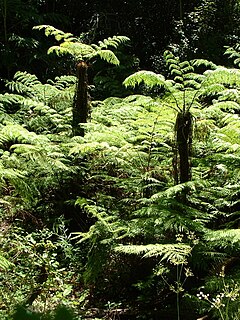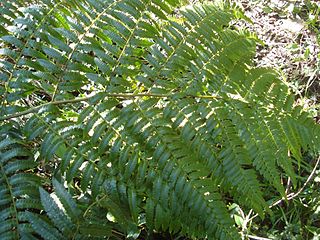Cyathea alpicola is a species of tree fern native to central Sumatra, where it grows in montane rain forest at an altitude of 2000–2750 m. The erect trunk can reach 5 m or more in height. Fronds are bi- or tripinnate and usually 2–3 m long. They have a tendency to persist on the plant after withering, forming an irregular skirt around the trunk. This species has a spiny stipe, which is covered with a woolly layer of scales. There appear to be two forms with different scales; either dark glossy brown with a broad paler margin and fragile edges, or small, brown and finely fringed. Sori are covered by thin, fragile indusia and occur near the midvein of fertile pinnules. The closest relative of C. alpicola is thought to be Cyathea polycarpa, which differs by lacking spines altogether. Cyathea macropoda and Cyathea magnifolia may also be closely allied with this species.
Cyathea baileyana, also known as the wig tree fern, is a species of tree fern native to northeastern Queensland in Australia, where it grows in wet gullies and forest at an altitude of 850–1200 m. It is a rare species that is seldom found in the wild. The erect trunk is 4–5 m tall, approximately 10 cm in diameter and may be covered in stipe bases in the upper regions. C. baileyana is notable for being able to develop offshoots from the base of the trunk. Fronds are bi- or tripinnate and may be exceptionally long, up to 7 m, though they are usually around 2–3 m. The rachis and stipe are dark to darkish red, scaly and may be warty, but lack spines. Scales on the rachis and stipe are purplish brown to black and have a long hair-like apex. Characteristically of this species, the last pair of pinnae are separated from the others along the rachis and may form a clump around the trunk apex. Sori are circular and occur in one to three rows along the pinnule midvein. They lack indusia.
Cyathea balanocarpa is a species of tree fern native to Cuba, Jamaica and Hispaniola. Despite its wide distribution, little is known about this species. It is apparently of hybrid origin.

Cyathea brevipinna is a species of tree fern endemic to the higher parts of Mount Gower on Lord Howe Island, where it grows in exposed areas at an altitude of about 790 m. The trunk is erect and may reach 3 m in height. It is often covered with reddish brown scales and stipe bases. This species may produce stolons at ground level. Fronds are tripinnate, densely crowded, and up to about 3 m long. The stipe is brown and sometimes warty after scales fall off. The scales are long, glossy dark brown, with a distinctly narrow apex and fragile paler edges. Sori are attached to deeply divided fertile pinnules that may uncurl over the sori. Indusia are firm and large. C. brevipinna is a stunted plant with short pinnae.
Cyathea brooksii is a species of tree fern native to Cuba, Hispaniola and Puerto Rico, where it grows on serpentine soils in shaded ravines, along streams, and on forested slopese at an altitude of 250–950 m. The trunk is prostrate and only about 6 cm in diameter. Fronds are pinnate or bipinnate and up to 2 m long. The base of the rachis is covered with blackish scales that have a paler margin. Sori occur in two rows, one along each side of the pinnule midvein.
Cyathea bryophila is a species of tree fern native to Puerto Rico, where it grows in the understory in wet montane and mossy forest at an altitude of 750–1200 m. The trunk is erect, up to 7 m tall and about 10 cm in diameter. Fronds are pinnate or bipinnate and grow to 2 m in length. The underside of the rachis is pubescent and has occasional scales towards the base. The scales range in colour from brown to bicoloured. Sori occur along each side of the pinnule midvein and are covered by scale-like indusia. C. bryophila is a slow growing species, reportedly only increasing in trunk height by 5 cm a year, a growth rate more akin to that of Dicksonia species. It has been estimated that plants may live in excess of 150 years.

Cyathea capensis is a regionally widespread and highly variable species of tree fern. It is indigenous to Southern Africa and South America.
Cyathea cinerea is a species of tree fern endemic to Mindanao in the Philippines, where it grows in forest at an altitude of about 1000 m. The trunk is erect, up to 5 m tall and about 12 cm in diameter. Fronds are bi- or tripinnate and 1–2 m long. The stipe has long spines and scattered scales, which are either narrow and pale or wide and brown. Sori occur near the midvein of fertile pinnules and are covered by brown indusia.

Cyathea colensoi, also known as the Creeping Tree Fern, Mountain Tree Fern and Golden Tree Fern, is a species of tree fern native to New Zealand, from the southern part of the North Island south to Stewart Island. It grows in submontane to montane forest in damp areas, particularly near the tree line. The trunk is usually prostrate, but may sometimes be erect. It may reach about 1 m in height. Fronds are tripinnate and about 1.5 m long or more. The rachis and stipe are slender, pale brown and are covered with brown scales. Sori occur in two rows, one along each side of the fertile pinnule midvein, and lack indusia. Plants form a thicket with no sign of a trunk.
Cyathea corcovadensis is a species of tree fern native to Paraguay and Serra do Mar in southern Brazil, where it grows in primary and secondary forest, as well as scrub, at an altitude of 250–2100 m. The erect trunk is short, usually about 30–60 cm tall. Fronds are bipinnate and 2.5 m or more in length. The rachis ranges in colour from brown to purplish and is covered with warts and scattered brown scales. Sori occur either between the fertile pinnule midvein and the edge of the lamina or just beside the midvein. They lack indusia. C. corcovadensis is a variable species, especially in terms of pinnule shape and degree of dissection.

Cyathea cunninghamii, also known as the gully tree fern and slender tree fern, is a species of tree fern indigenous to New Zealand including North Island, South Island and Chatham Islands; also to Victoria, possibly New South Wales, southeastern Queensland and Tasmania in Australia. It grows in damp forest, often emerging from stream gullies and riverbanks. Brownsey noted that it has a lower tolerance for drought than other species of Cyathea. The erect trunk may be 20 m tall and is usually 6–15 cm in diameter, occasionally as much as 20 cm. Fronds are tri- to tetrapinnate and 3 m or more in length. The rachis and stipe are slender, black brown, warty and covered with brown scales. Sori occur along each side of the pinnule midvein and are covered by hood-like indusia. C. cunninghamii is an uncommon and slow-growing tree fern.

Cyathea dregei is a widespread species of tree fern in southern Africa.
Cyathea fenicis is a species of tree fern native to the Philippines, Taiwan, and Orchid Island, where it grows in wet forest, forest margins and on hillsides. The trunk is erect, up to 1 m tall and about 6 cm in diameter. Fronds are tripinnate and 1.5–2 m long. Characteristically of this species, the lowest pinnae are usually reduced. The stipe is spiny and ranges in colour from brown to purple-dark brown. It bears two types of scales: long dark brown scales as well as minute brown ones. Occasionally the scales are pale. Sori are round and arranged in two rows, one on either side of the pinnule midvein. They are covered by very small indusia that resemble scales in appearance.
Cyathea squamulata is a species of tree fern native to the Malay Peninsula, Sumatra, Java, Borneo and the southern Philippines, including the Sulu Archipelago, where it grows in forest from the lowlands to an altitude of about 1500 m. The trunk is erect and up to 2 m tall. Fronds are pinnate or bipinnate and approximately 1.5 m long. The stipe is covered in densely packed firm, medium brown scales. Sori occur near the fertile pinnule midvein and lack indusia.
Cyathea fulgens is a species of tree fern native to Cuba, Jamaica and Hispaniola. It forms part of the complex centered on Cyathea woodwardioides comprising six very similar taxa from the Greater Antilles. The other five species are Cyathea crassa, Cyathea grevilleana, Cyathea portoricensis and Cyathea tussacii. Large and Braggins (2004) note that this group is known to cross with members of the Cyathea minor complex. In the wild, C. fulgens also forms hybrids with Cyathea brooksii.
Cyathea hancockii is a species of tree fern native to the Ryukyu Islands, Japan, Taiwan and Hong Kong. The specific epithet hancockii commemorates William Hancock (1847-1914), who collected numerous plants in Japan, China and Southeast Asia. It grows in forest, on stream banks, and in forest margins at an elevation of about 600 m or higher.

Cyathea delgadii is a widespread species of tree fern native to Costa Rica, Panama, Venezuela, French Guiana, Guyana, Trinidad, Colombia, Ecuador, Peru, Bolivia, Argentina, Paraguay, and Brazil.
Cyathea metteniana is a species of tree fern native to the Ryukyu Islands, Japan, and Taiwan, where it grows in wet forest, forest margins, and on hillsides. The trunk of this plant is erect, up to 1 m tall, and 6–10 cm in diameter. C. metteniana has tripinnate fronds that are 1-2.5 m long. The stipe is brown to purple-black in colouration. It is covered in long, broad-based scales that are usually bicoloured. Sori are round, lack indusia, and occur in two rows, one on either side of the pinnule midvein.
Cyathea imbricata is a species of tree fern endemic to Western New Guinea, where it grows in open forest at an altitude of 3240 m. The trunk of this plant is erect and approximately 2 m tall. Fronds may be bi- or tripinnate and are usually less than 1 m in length. The stipe is dark, spiny, and covered with caducous scales. These scales are glossy brown in colouration and have a paler margin and fragile edges. Sori are borne in groups of one to four per pinnule lobe. They are protected by firm indusia.
Cyathea latipinnula is a species of tree fern native to the Philippines, where it grows in ridge forest at an altitude of about 1400 m. The trunk of this plant is erect and grows to 1–2 m in height and 10 cm in diameter. Fronds may be bi- or tripinnate and 1–2 m in length. The stipe is spiny and bears a few narrow, brown basal scales. Sori are borne near the fertile pinnule midvein and are protected by small, dark indusia.









